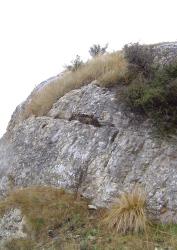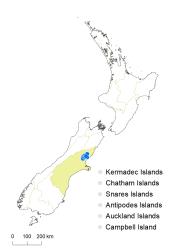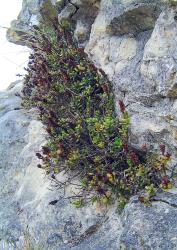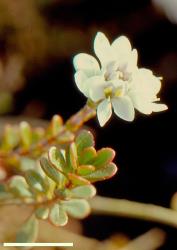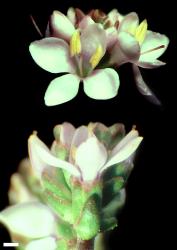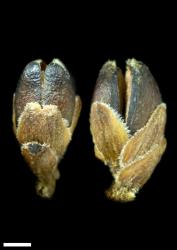- ≡ Hebe raoulii var. maccaskillii Allan, Trans. & Proc. Roy. Soc. New Zealand 69: 273 (1940)
- ≡ Heliohebe raoulii subsp. maccaskillii (Allan) Garn.-Jones, New Zealand J. Bot. 31: 335-336 (1993)
- ≡ Parahebe raoulii subsp. maccaskillii (Allan) Heads, Bot. J. Linn. Soc. 115: 82 (1994)
- ≡ Veronica raoulii subsp. maccaskillii (Allan) Garn.-Jones in Garnock-Jones et al., Taxon 56: 578 (2007)
- ≡ Heliohebe maccaskillii (Allan) D.A.Norton & Molloy, New Zealand J. Bot. 47: 406 (2009)
Sub-shrub or low shrub to 0.3 m tall. Stems prostrate to decumbent, almost divaricating, eglandular-pubescent; hairs uniform, short, reflexed, appressed. Leaf bud indistinct; leaves separating while very small, opposite-decussate, erecto-patent to spreading, separating early; lamina coriaceous, obovate to spathulate, 4–15 mm long, 2–7 mm wide, dull green to bronze-green above, dull bronze-green to yellowish-green beneath; midrib weakly evident; surfaces glabrous; margin glabrous, entire to shallowly crenate, teeth in 0–3 pairs; apex rounded or rarely obtuse; base cuneate; petiole 1–3 mm long. Inflorescence a terminal compound raceme, 15–30 mm long; flowers crowded, 10–60, all bisexual; bracts opposite, becoming alternate above, deltoid, > pedicels; pedicels erecto-patent, 0–0.5 mm long, densely eglandular-hairy all around. Calyx lobes usually 5, sometimes 4, the anterior pair fused about ⅔-way to apex or sometimes less, rounded to obtuse, 2–3 mm long, posterior 5th lobe about ½–⅔ as long as the others, eglandular-ciliate, or mixed eglandular- and glandular-ciliate. Corolla 5.0–9.5 mm diameter; tube white or pale purplish, 2–3 mm long, ≤ calyx, glabrous; lobes 4, white or pale purplish, erect to spreading, sub-equal, elliptic to narrowly rhomboid, 3.0–4.5 mm long, sub-acute to rounded; nectar guides absent. Stamen filaments white, 2.0–3.5 mm long; anthers pale yellow. Style glabrous or with a few hairs at base, 4–7 mm long. Capsules turgid or broadly angustiseptate, emarginate, glabrous or hairy at apex, 2.5–3.5 mm long, 2–3 mm at widest point. Seeds fusiform or irregular, weakly flattened, winged, smooth, straw-yellow to brown, 1.2–1.6 mm long.
Among the species of the sun hebe group, plants of V. hulkeana and V. lavaudiana can be distinguished by their larger leaves. V. raoulii plants are very similar in having the anterior calyx lobes fused, but distinguished by their more open and ascending to erect habit, with at least some longer internodes 5–8 mm (consistently < 5 mm in V. maccaskillii), larger, obovate to spathulate and more acute to acuminate leaves with more and deeper teeth, and only four calyx lobes. These differences are mostly quantitative, the only qualitative one being the fifth calyx lobe often seen in V. maccaskillii. Norton & Molloy (2009) report both species grow together on Mt Cass, North Canterbury, without obvious hybrids, and this sympatric occurrence was the reason they promoted V. raoulii subsp. maccaskillii to species rank (as Heliohebe maccaskillii).
V. scrupea plants differ in having four calyx lobes, and their leaves are narrower, more toothed, and more acute, their flowers are smaller with shorter stamens, and their anterior calyx lobes are free. V. pentasepala plants are taller and more erect, but similar in having five calyx lobes.
South Island: Canterbury (confined to a small area near Waipara and Rangiora, including Pyramid Valley, Waipara Gorge and nearby hills, Weka Pass, Whiterock, and Mt Cass).
Limestone gorges and ridges, rock outcrops. Recorded elevations range from 91 to 500 m.
Flowers: October–November; fruits: December–January.
2n = 42 (Hair 1967, as Hebe raoulii var. maccaskillii).
Veronica maccaskillii is classified in V. subg. Pseudoveronica sect. Hebe and informally in the “sun hebe” group (Albach & Meudt 2010). The morphology-based cladogram of Garnock-Jones (1993) suggests a close relationship with V. raoulii. DNA sequence data have not been studied.
V. maccaskillii was reported to grow with V. raoulii at Mt Cass, Canterbury, where hybrids between them were not seen (Norton & Molloy 2009, as Heliohebe). However, all calyces examined from Mt Cass specimens had free anterior lobes, so those specimens would not key out to either species in most keys. Sharing of this feature might indicate gene flow among all the plants at this locality.



